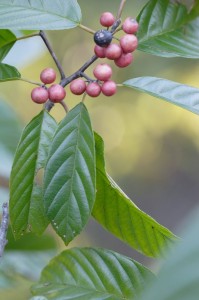Many native plant enthusiasts consider the Carolina Buckthorn, aka Indian cherry (Rhamnus caroliniana), one of our most underutilized native shrubs or small trees. It suffers with a bad common name as it has no thorns or spines. This open, slender branched shrub grows 12 to 15 feet high and 10 to 15 feet wide. (USDA hardiness zones 5-9).
Bright green leaves remain on long into autumn before eventually turning a blah yellow-green color. In southern areas much of the yellowed foliage holds through most of the winter. Spring flowers, mostly inconspicuous, are followed by 1/3 inch diameter green berries (drupes).
High point for this shrub is its brightly colored red fruits starting in late summer and eventually ripen to black in late September into October. Birds and other wildlife will devour the edible black fruits in the fall and early winter. Main trunk(s) and branches flaunt a smooth gray bark.
Carolina Buckthorn should be grown in full sun on well-drained soil, acidic or alkaline. Specimens reaching 25-30 feet can be found on moist woodland sites. It will tolerate moderate dry spells.
Buckthorns are rarely troubled by insect pests, but individual plants may be severely setback by a crown rust and by leaf spot diseases. Carolina buckthorn is easily trained into a small tree suited for planting under power lines. Training a young shrub into a small tree is not difficult. Plant several to form a hedge or thicket to shelter wildlife and provide them a feeding station.


 Posted in
Posted in 
